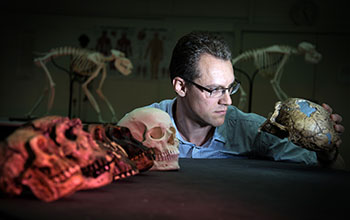Multimedia Gallery
Predicting human evolution: teeth tell the story (Image 2)
Alistair Evans, an evolutionary biologist at Monash University, examines a range of hominin skull casts that were included in a study that found the evolution of human teeth is much simpler than was previously thought. [Image 2 of 2 related images. Back to Image 1.]
More about this image
A new study by an international team of anthropologists took a fresh look at the teeth of humans and fossil hominins and confirmed that molars, including wisdom teeth, do follow the sizes predicted by what is called "the inhibitory cascade" -- a rule that shows how the size of one tooth affects the size of the tooth next to it. The research is important because it indicates that human evolution was a lot simpler than scientists had previously thought.
"Teeth can tell us a lot about the lives of our ancestors, and how they evolved over the last seven million years," says Alistair Evans, an evolutionary biologist at Monash University and lead on the research. "What makes modern humans different from our fossil relatives? Palaeontologists have worked for decades to interpret these fossils and looked for new ways to extract more information from teeth."
The research challenges the accepted view that there was a lot of variation in how teeth evolved in our closest relatives.
For the study, the team used a new extensive database on fossil hominins and modern humans collected over several decades, as well as high resolution 3D imaging to see inside the fossil teeth. Next, the team applied the findings to two main groups of hominins: the species in the genus Homo (like us and Neanderthals) and australopiths, including specimens like Lucy, the famous fossil hominin from Africa.
While it was discovered that both groups follow the inhibitory cascade, Evans says they do so slightly differently.
"What’s really exciting is that we can then use this inhibitory cascade rule to help us predict the size of missing fossil teeth," says Evans. "Sometimes we find only a few teeth in a fossil. With our new insight, we can reliably estimate how big the missing teeth were. The early hominin Ardipithecus is a good example -- the second milk molar has never been found, but we can now predict how big it was."
The findings of the study, which was funded by the National Science Foundation, will be very useful in interpreting new hominin fossil finds, and looking at what the real drivers of human evolution were. As well as shedding new light on our evolutionary past, this simple rule provides clues about how we may evolve into the future. (Date image taken: Unknown; date originally posted to NSF Multimedia Gallery: March 18, 2016)
Credit: David Hocking, Monash University
See other images like this on your iPhone or iPad download NSF Science Zone on the Apple App Store.
Images and other media in the National Science Foundation Multimedia Gallery are available for use in print and electronic material by NSF employees, members of the media, university staff, teachers and the general public. All media in the gallery are intended for personal, educational and nonprofit/non-commercial use only.
Images credited to the National Science Foundation, a federal agency, are in the public domain. The images were created by employees of the United States Government as part of their official duties or prepared by contractors as "works for hire" for NSF. You may freely use NSF-credited images and, at your discretion, credit NSF with a "Courtesy: National Science Foundation" notation.
Additional information about general usage can be found in Conditions.
Also Available:
Download the high-resolution JPG version of the image. (8.8 MB)
Use your mouse to right-click (Mac users may need to Ctrl-click) the link above and choose the option that will save the file or target to your computer.



